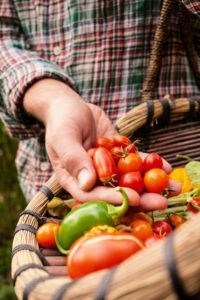I started hearing about Community-Supported Agriculture (CSA) many years ago, and knew I had to get on board. I signed up with great anticipation, and my weekly deliveries did not disappoint. Whether you have thought about CSAs or find it a new concept, consider the benefits to making this your year to become a CSA member.
 Community-Supported Agriculture is the practice of helping farmers sell directly to consumers. Consumers pay a membership fee, or investment, at the beginning of the season; this provides capital for the farmer’s seasonal startup costs. In return, the consumer receives farm-raised goods later, usually on a weekly or monthly schedule. CSA programs are sometimes called farm shares, since consumers are buying a share of the farm’s production as well as a share of the risk.
Community-Supported Agriculture is the practice of helping farmers sell directly to consumers. Consumers pay a membership fee, or investment, at the beginning of the season; this provides capital for the farmer’s seasonal startup costs. In return, the consumer receives farm-raised goods later, usually on a weekly or monthly schedule. CSA programs are sometimes called farm shares, since consumers are buying a share of the farm’s production as well as a share of the risk.
CSA products range from vegetables, herbs and fruit to meat, poultry, eggs, flowers, honey, coffee and bread. The variety and amount of food depend on location and season. An example of a small weekly vegetable share might include a half pound each of kale and lettuce, one bunch of carrots, a pound of tomatoes and a cucumber, while a large share may contain those vegetables as well as one bunch of swiss chard, herbs and a pound of summer squash. At another farm, a spring box may include lettuce, radishes, cauliflower, spinach, golden beets, kale, bok choy and leeks. Some farms pack your weekly box while others let you pick what you take home each week.
Annual CSA membership or farm share fees vary, with a typical small share costing $300, a medium share costing $500, and a large share costing $700. A small share is recommended for a single person, a medium for two to three people, and a large for a family or even couples who eat a largely plant-based diet and want to store/preserve a portion of the produce. Some farms also let you choose a share in which you get a box every two weeks.
At a cost of $12 to $22 per week on average, a CSA membership may be less or more than you usually spend on produce. You receive four to 20 pounds and five to eight varieties of produce each week, depending on your share size and time of the season. Even if this is more than you usually spend, one benefit of a CSA is its tendency to encourage an increased intake of vegetables.
There are numerous additional benefits of a CSA. Many farms provide newsletters and recipes, and most are willing to answer questions about their practices. Your bounty will typically be fresher, tastier and more varied than produce in a store, and you will be more connected to the earth as you receive foods in season. Most CSAs are organic, and some let you work the land if you are interested. Best of all, you will be supporting a local farmer, keeping land from development and helping the local economy.
To find a program that fits your needs, explore http://www.localharvest.org/fort-collins-co/csa and start enjoying fresh-picked local produce!
Melissa Wdowik, PhD, RDN, FAND, is an assistant professor at Colorado State University in the Department of Food Science and Human Nutrition, and director of the Kendall Reagan Nutrition Center.





